Obesity and Cancer: The Risks, Science, and Potential Management Strategies
Overweight and obesity increase the risk of developing several cancers.Once cancer develops, individuals may be at increased risk of recurrenceand poorer survival if they are overweight or obese. A statisticallysignificant association between overweight or obesity and breast cancerrecurrence or survival has been observed in the majority of populationbasedcase series; however, adiposity has been shown to have less of aneffect on prognosis in the clinical trial setting. Weight gain after breastcancer diagnosis may also be associated with decreased prognosis. Newevidence suggests that overweight/obesity vs normal weight may increasethe risk of poor prognosis among resected colon cancer patients and therisk of chemical recurrence in prostate cancer patients. Furthermore, obesecancer patients are at increased risk for developing problems followingsurgery, including wound complication, lymphedema, second cancers,and the chronic diseases affecting obese individuals without cancer suchas cardiovascular disease and diabetes. Mechanisms proposed to explainthe association between obesity and reduced prognosis include adiposetissue-induced increased concentrations of estrogens and testosterone,insulin, bioavailable insulin-like growth factors, leptin, and cytokines.Additional proposed mechanisms include reduced immune functioning,chemotherapy dosing, and differences in diet and physical activityin obese and nonobese patients. There have been no randomized clinicaltrials testing the effect of weight loss on recurrence or survival inoverweight or obese cancer patients, however. In the absence of clinicaltrial data, normal weight, overweight, and obese patients should beadvised to avoid weight gain through the cancer treatment process. Inaddition, weight loss is probably safe, and perhaps helpful, for overweightand obese cancer survivors who are otherwise healthy.
Overweight and obesity increase the risk of developing several cancers. Once cancer develops, individuals may be at increased risk of recurrence and poorer survival if they are overweight or obese. A statistically significant association between overweight or obesity and breast cancer recurrence or survival has been observed in the majority of populationbased case series; however, adiposity has been shown to have less of an effect on prognosis in the clinical trial setting. Weight gain after breast cancer diagnosis may also be associated with decreased prognosis. New evidence suggests that overweight/obesity vs normal weight may increase the risk of poor prognosis among resected colon cancer patients and the risk of chemical recurrence in prostate cancer patients. Furthermore, obese cancer patients are at increased risk for developing problems following surgery, including wound complication, lymphedema, second cancers, and the chronic diseases affecting obese individuals without cancer such as cardiovascular disease and diabetes. Mechanisms proposed to explain the association between obesity and reduced prognosis include adipose tissue-induced increased concentrations of estrogens and testosterone, insulin, bioavailable insulin-like growth factors, leptin, and cytokines. Additional proposed mechanisms include reduced immune functioning, chemotherapy dosing, and differences in diet and physical activity in obese and nonobese patients. There have been no randomized clinical trials testing the effect of weight loss on recurrence or survival in overweight or obese cancer patients, however. In the absence of clinical trial data, normal weight, overweight, and obese patients should be advised to avoid weight gain through the cancer treatment process. In addition, weight loss is probably safe, and perhaps helpful, for overweight and obese cancer survivors who are otherwise healthy.
Overweight and obesity increase the risk of developing several types of cancer.[1] Depending on the disease site, individuals who develop cancer may be at increased risk of recurrence and poorer survival if they are overweight or obese. The vast preponderance of information on the effect of adiposity on prognosis is limited to breast cancer, although data are emerging on additional cancer sites (particularly the colon and prostate). However, the mechanisms that might explain the association between adiposity and prognosis may pertain to sites other than the breast. The effects of obesity on cancer outcome are substantial, where observed, and of potentially great clinical importance. The prevalence of overweight and obesity is higher in patients with some forms of cancer, compared with individuals from the general population.[1] Compounding this is the fact that weight gain after diagnosis is common in some cancer patients; this is especially true among breast cancer patients receiving systemic adjuvant therapy.[2,3] Weight gain during the period after breast cancer diagnosis has also been associated with an adverse effect on recurrence risk and survival.[2] In addition to adversely affecting prognosis, overweight and obesity also increase both the risk of several complications from cancer treatment and the risk of several comorbidities. There are several potential mechanisms that might explain the link between increased adiposity and reduced prognosis, including hormonal, inflammatory, and immune system effects. Although definitive clinical trials testing the effect of weight loss on prognosis in cancer patients have not been conducted, strategies for weight control may be helpful for some cancer patients and survivors. There are several ways to measure body composition and adiposity. Simple, inexpensive, and noninvasive techniques include measuring height, weight, body mass index (BMI, kg/m2), and waist and hip circumferences; employing bioelectric impedance analysis (which estimates percent body fat); and using fat calipers (which can be used to estimate overall and regional body fat). Other body composition measures give more reliable and valid measures of body composition, but are more invasive and expensive. The latter category includes underwater weighing (considered the "gold standard" for body composition), dual-energy x-ray absortiometry (DEXA) scan (which measures lean mass, bone mass, and fat mass), computed tomography (CT) scan, and magnetic resonance imaging (MRI) scan (used to estimate intra-abdominal and subcutaneous abdominal fat, typically measured with one crosssectional slice in order to reduce radiation exposure and costs). Body mass index is the measure of adiposity most commonly used in studies of obesity and breast cancer. For comparison purposes, it is the one used throughout this article. Obesity experts have developed the following categories of adiposity based on BMI[4]: underweight (< 18.5), normal weight (18.5-24.9), overweight (25.0-29.9), and obese (≥ 30.0) (Table 1). Obesity is further subclassified; the most important subclassification is ≥ 40.0, or extreme obesity, as individuals often have serious metabolic complications at this level of obesity. Overweight, Obesity, and Breast CancerNonpatient Populations
In the American Cancer Society Prevention Study II, a prospective cohort study of 900,000 American adults, 57,145 cancer deaths were identified during 16 years of followup.[ 5] Cancer mortality was determined through personal inquiries and linkage with the National Death Index. The relative risk (RR) for breast cancer associated with categories of increasing BMI, compared with women with BMI < 25.0, were as follows: 1.34 (BMI 25.0-29.9), 1.63 (BMI 30.0-34.9), 1.70 (BMI 35.0-39.9), and 2.12 (BMI ≥ 40.0). The test for trend was highly significant (P < .001). For men, the relative risk of death from any cancer was 1.52 (95% confidence interval [CI] = 1.13-2.05); for women, the relative risk was 1.62 (95% CI = 1.40-1.87).[5] In both men and women, BMI was also significantly associated with higher rates of death due to cancer of the esophagus, colon and rectum, liver, gallbladder, pancreas, and kidney, as well as non- Hodgkin's lymphoma and multiple myeloma. Significant trends of increasing risk of death with higher BMIs were observed for cancers of the stomach and prostate in men and cancers of the breast, uterus, cervix, and ovary in women. In the Iowa Women's Health Study, with a cohort of 21,707 women, a positive association of waist-hip ratio with breast cancer mortality was also observed after follow-up of up to 7 years.[6] Because these studies did not focus on a patient population, but rather on risk in an originally cancer-free population, it is not clear how much of the effect of BMI on mortality was due to increased cancer incidence with obesity, and how much was due to decreased survival among obese cancer patients. Indeed, increased adiposity has been found to be associated with increased incidence of cancers of the breast (postmenopausal), colon, endometrium, lower esophagus, kidney, and pancreas,[1,7-9] poor prognosis among breast, colon, and prostate cancer patients,[2,10-12] and stage at diagnosis.[11-15] Patient Populations
Nearly 40 studies have examined the association of obesity with breast cancer outcomes in patient populations.[ 2,3] A statistically significant association between overweight or obesity and recurrence or survival was seen in 26 reports that included a total of 29,460 women with breast cancer, while several studies including over 5,000 women did not yield such associations.[ 2] Negative effects of body weight on breast cancer recurrence and survival have been observed in both pre- and postmenopausal women.[ 2] Interestingly, the association between increased adiposity and reduced prognosis has largely been observed in hospital-based case series and population- based studies. Some cooperative groups have published data on the effect of overweight or obesity on prognosis, with varying results.[16,17] Goodwin et al conducted a metaanalysis of studies published prior to 1992 and estimated that overweight or obesity was associated with a statistically significantly increased risk of recurrence (78% to 91%) and a 36% to 56% increased risk of death.[18] In another study, obesity was strongly and statistically significantly associated (P = .005) with disease- free survival and overall survival in a cohort of 535 women (median age: 50 years) with newly diagnosed breast cancer. In addition, obesity at diagnosis was related (hazard ratio [HR] = 1.86, 95% CI = 1.02-3.40) to a significant decrease in survival in postmenopausal women with inflammatory breast cancer.[19] These associations between obesity and adverse breast cancer outcome are substantial, with differences comparable in magnitude to those associated with adjuvant hormonal therapy and chemotherapy, and of potentially great clinical importance. A recent review of published prospective studies of adiposity and breast cancer prognosis[2] concluded that the majority of studies identified a significant adverse association of obesity with either recurrence or death. Despite these numerous studies, it is still not clear whether there are interactions with adjuvant therapy. A recent National Surgical Adjuvant Breast and Bowel Project (NSABP) analysis of 3,385 patients from a randomized, placebo-controlled trial evaluating tamoxifen for lymph node-negative, estrogen receptor (ER)-positive breast cancer found that obese women benefited from tamoxifen therapy as much as lighterweight women did.[16] Futhermore, in that population, BMI was not adversely associated with breast cancer mortality. Compared with normal weight women, obese women had greater allcause mortality (HR = 1.31, 95% CI = 1.12-1.54) and greater risk of death due to causes unrelated to breast cancer (HR = 1.49, 95% CI = 1.15-1.92). Goodwin et al recently reported a prospective cohort study that was designed to examine the prognostic effect of obesity in early-stage breast cancer.[20] Height and weight were measured in a fasting state prior to initiation of adjuvant treatment in 535 women with T1-3, N0/1, M0 breast cancer. After a median follow-up of 50 months, obesity predicted distant disease-free and overall survival (P < .001). Women with BMI 20-25 had the lowest risk of recurrence and death; those with BMI < 20 or BMI > 25 had an increased risk of recurrence (RR = 1.18 and 1.72, respectively) and death (RR = 1.21 and 1.78, respectively). The adverse effect of obesity persisted after adjustment for tumor stage, nodal stage, tumor grade, estrogen and progesterone receptor status, and adjuvant treatment (chemotherapy and/or hormone therapy). All but two of the deaths were due to breast cancer. Body fat distribution may be relevant to breast cancer prognosis. Researchers in British Columbia, Canada, identified 603 patients with incident breast cancer and collected self-reported anthropometric data prior to treatment.[ 21] After up to 10 years of follow-up, the relative risk for breast cancer mortality for highest vs lowest quartile of waist-to-hip ratio in postmenopausal cases was 3.3 (95% CI = 1.1-10.4). The increased mortality risk was limited to those with ER-positive tumors. A small study found that increased truncal obesity significantly predicted breast cancer survival.[22] In that study, 83 of 166 breast carcinoma patients (50%) with up to 10 years of follow-up died of their breast cancer. Android body fat distribution, as indicated by a higher suprailiacthigh ratio, was a statistically significant (P < .0001) prognostic indicator for survival after controlling for stage of disease, with a hazard ratio of 2.6 (95% CI = 1.63-4.17). Risk of future second primary breast cancer may also be increased with increased adiposity. Results from a population-based cohort of 1,285 breast cancer survivors suggest an increased risk for contralateral breast cancer among overweight or obese breast cancer survivors.[23] In the NSABP analysis of 3,385 tamoxifen patients, contralateral breast cancer hazard was higher in obese women than in underweight/normal weight women (HR = 1.58, 95% CI = 1.10- 2.25), as was the risk of additional primary breast cancers (HR = 1.62, 95% CI = 1.16-2.24).[16] Overweight, Obesity, and Other Cancers In a series of 1,106 prostate cancer cases from several institutions, obese patients were found to have highergrade tumors and higher rates of positive surgical margins.[11] In a multivariate analysis of these patients, BMI > 35.0 was a significant predictor of biochemical failure. In another multi-institutional pooled analysis of 3,162 men, BMI was an independent predictor of higher Gleason grade cancer, and was associated with a higher risk of biochemical recurrence.[12] In a cohort of 3,759 colon cancer patients in a randomized adjuvant chemotherapy trial, obese women had a statistically significant (34%) increased risk of overall mortality and a nonsignificant (24%) increased risk of disease recurrence after a mean 9.4 years follow-up.[10] However, obesity was not associated with prognosis in men in the same cohort. In two single-hospital case series, increased BMI was associated with improved prognosis in over 1,000 renal cancer patients.[24,25] Effect of Weight Gain After Diagnosis and Risk of Cancer Mortality Weight gain after diagnosis has been frequently reported for breast cancer patients, especially among women receiving systemic adjuvant chemotherapy.[2] In a prospective cohort of 535 newly diagnosed breast cancer patients, adjuvant chemotherapy and onset of menopause were the strongest predictors of weight gain.[26] The causes of this weight gain have not been identified but could be from a mixture of reduced physical activity after diagnosis,[27] changes in dietary intake,[26,28] and reduced rates of metabolism.[3] In the Health, Eating, Activity, Lifestyle (HEAL) study, a population-based cohort of 1,185 women with stage 0 to IIIA breast cancer, levels of recreational physical activity significantly decreased between diagnosis and 1 year after diagnosis regardless of age at diagnosis (Figure 1).[27] This decrease was seen in women at all stages, although it was most pronounced in the higher stages (Figure 2). Women who had been treated with chemotherapy were more likely to decrease their activity levels, although women with any treatment were likely to have reduced activity levels (Figure 3). Obese women reduced their activity levels more than did lighter-weight women (Figure 4). The amount of decrease in physical activity could explain the degree of weight gain in those who gained weight after diagnosis, even without changes in dietary composition.
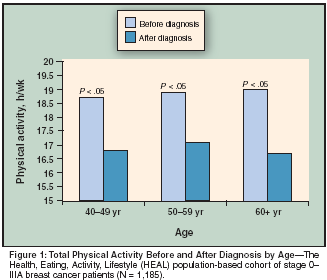
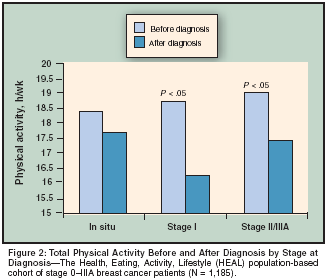
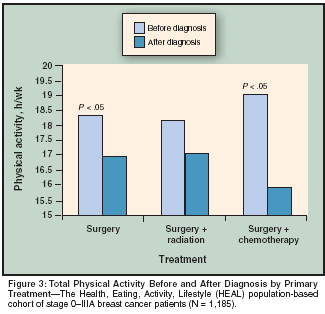
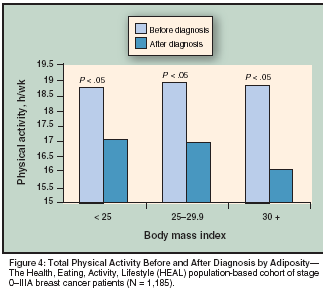
One report suggested associations between obesity, depressive symptomatology, and abnormal eating attitudes in women at risk for breast cancer recurrence, which could compound patients' attempts to maintain or lose excess weight.[28] Tamoxifen treatment does not appear to influence body weight.[26,29] Although anthracycline chemotherapy may have less of an effect on weight than other chemotherapy regimens, weight gains of between 2 and 4 kg have commonly been reported following some chemotherapy regimens such as CMF (cyclophosphamide, methotrexate, fluorouracil [5-FU]).[30] This weight gain consists primarily of body fat. In a report of the National Cancer Institute of Canada Clinical Trials Group, adjuvant CMF and CEF (cyclophosphamide, epirubicin, 5-FU) was associated with average weight increases of 4.36 and 2.93 kg, respectively (P < .001 compared to baseline).[31] In breast cancer survivors, return to prediagnosis weight is rare.[2] Four studies have investigated the relationship between weight gain after diagnosis and prognosis.[2] Three of these studies in early-stage resected breast cancer found that weight gain after diagnosis increased recurrence risk or deceased survival. Obesity and Development of Comorbidities
Obese cancer patients are at increased risk for developing problems following surgery, including wound complications, lymphedema, and perhaps congestive heart failure in women who had received doxorubicin.[2] Obesity is also a risk factor for endometrial cancer development; this may place women who take tamoxifen at further increased risk of developing this disease.[32] In a study of 1,800 postmenopausal breast cancer patients identified through the National Cancer Institute's Surveillance, Epidemiology, and End Results (SEER) program and followed for 30 months after diagnosis, only 51% of deaths were attributed to breast cancer[33]; the percentage of deaths ascribed to breast cancer decreased with age. Most prostate cancer patients die of causes other than their cancer, which underscores the need for healthy lifestyle recommendations for this patient population.[34] Attention to obesity as a risk factor for potentially fatal comorbid conditions such as cardiovascular disease, venous thromboembolic disease, and stroke, is of potential major importance in optimizing cancer patient outcome. This is especially true in older patient populations. Furthermore, obesity increases risk of several other cancers, including endometrial, renal, esophageal, and colon cancer.[1] Patients who have had a diagnosis of cancer are at increased risk for some of these cancers, and obese patients have a further increased risk. Obesity and Quality of Life in Cancer Patients
For some cancer patients and survivors, quality of life may be adversely affected by obesity.[35] Interventions that may reduce weight, conversely, such as increasing physical activity, have been shown to improve quality of life in cancer survivors.[36]Adverse Effect of Obesity on Prognosis: Potential Mechanisms Several mechanisms have been proposed to explain the adverse effect of obesity on cancer prognosis.[2] These mechanisms include increased levels of circulating hormones such as estrogen and androgens; reduced levels of sex hormone binding globulin, which thereby increases the levels of free estradiol and free testosterone; increased levels of insulin and insulin-like growth factors; reduced levels of the insulin-like growth factor binding protein; increased levels of cortisol and leptin; increased levels of cytokines; effects of diet; reduced immune functioning; and chemotherapy underdosing in obese patients. Although some biologic evidence exists to support many of these potential mechanisms, there is little direct evidence of their role. Estrogens, Androgens, and Adiposity in Women
Estrogens can promote growth of several hormone-dependent tumors, particularly those of the breast and endometrium; conversely, both adding antiestrogens and withdrawing endogenous estrogens are effective adjuvant treatments for breast cancer.[ 37,38] Postmenopausal women produce estrogens in fat and other tissue through the aromatization of androgens to estrogens. The enzyme aromatase is abundantly present in adipose tissue, especially subcutaneous fat. Estrogens are tumor promoters in vitro and in vivo, and women with high circulating levels of estrogens are at increased risk of developing breast cancer.[39] Postmenopausal women who are overweight or obese have elevated levels of estrogens compared with lighter-weight women. In a population- based cohort of 505 postmenopausal women with stage 0-IIIA breast cancer (the HEAL study), adiposity was positively and statistically significantly associated with circulating levels of estrone, estradiol, and free estradiol (Figures 5 and 6).[40]
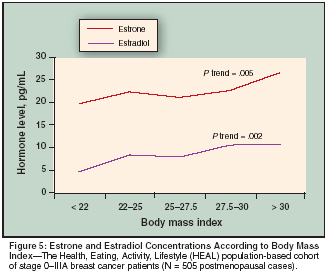
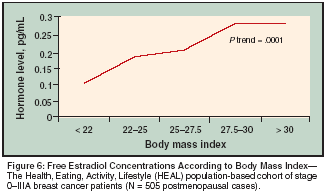
Women were identified to this study through the SEER cancer registries of western Washington and New Mexico, and were primarily Hispanic and non- Hispanic whites. Between 4 and 12 months after diagnosis, anthropometric measures and blood draws were obtained for all women and DEXA scans were obtained for 415 women. Obese (BMI ≥ 30) women had 35% higher concentrations of estrone and 130% higher concentrations of estradiol, compared with lighter (BMI < 22.0) women (P trend = 0.005 and 0.002, respectively). Similar associations were observed for DEXA-derived body fat mass and percent body fat, as well as waist circumference. Concentrations of free estradiol were doubled to tripled in overweight and obese women compared with lighter-weight women (P trend = .0001). Androgens
Overweight, obese, and sedentary postmenopausal women have elevated concentrations of circulating total and free androgens, which may be due to increased amounts of 17-betahydroxysteroid dehydrogenase in subcutaneous and intra-abdominal fat. A combined analysis of nested case-control studies within nine cohort studies, which included data from 663 breast cancer cases and 1,765 women without breast cancer, found that postmenopausal women with serum hormone concentrations in the top quintile for testosterone, androstenedione, dehydroepiandrosterone (DHEA), and DHEA-sulfate (DHEA-S) were approximately twice as likely to develop breast cancer compared with women with serum hormones in the bottom quintile.[39] In the same analysis, a doubling of androgen concentration resulted in a 20% to 40% increase in risk for breast cancer. When estradiol and testosterone were included in the same model, the effect of doubling testosterone on breast cancer risk was greater than that of estradiol (RR = 1.32 and 1.18, respectively), and similar results were observed for androstenedione when combined in a model with estradiol. These androgens may increase cell proliferation by being converted to estradiol and estrone in the circulation or target tissue. In addition, androgens may affect breast cancer risk by directly stimulating the growth and division of breast cells. In the HEAL cohort of breast cancer patients, overweight and obese women had statistically significantly elevated levels of testosterone, free testosterone, and DHEA-S (Figures 7 and 8).[40] Levels of DHEA-S and free testosterone were higher in women in the top quartiles for body fat mass compared with the leanest women, although the trend was only statistically significant for free testosterone.
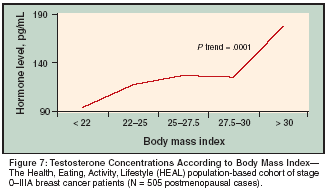
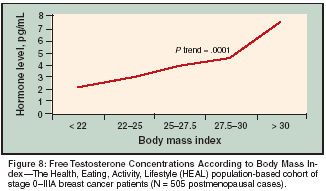
Insulin and Insulin-Like Growth Factors
High levels of insulin and C-peptide have been associated with increased risk for some common cancers, and insulin has mitogenic effects on breast and other tumor cells.[7] In a study of 535 women with early-stage breast cancer, Goodwin et al investigated several of these potential mediators.[20] Fasting insulin levels were significantly associated with both distant recurrence and death. Women in the highest quartile of insulin levels had a 2.1 times increased risk of distant recurrence compared to those in the lowest quartile (95% CI = 1.2-3.6, P = .01) and a 3.3 times greater risk of death (95% CI = 1.5-7.0, P = .002); results adjusted for age, nodal stage, tumor stage, tumor grade, hormone receptor status, adjuvant chemotherapy, and adjuvant tamoxifen. The effect of insulin on survival was independent of BMI. Circulating insulin-like growth factor 1 (IGF-1), IGF-2, insulin-like growth factor binding protein (IGFBP-1 and IGFBP-3), and estradiol did not exert independent effects on distant recurrence or death. Hyperinsulinemia could affect cancer prognosis in several ways. Insulin has been found to stimulate ER-alpha in breast cancer cells in vitro. Insulin also stimulates the production of estrogens and androgens (increasing production of these by adipose tissue) and downregulates sex hormone binding globulin, the major carrier molecule for estradiol and testosterone, which can be relevant for breast, endometrial, and prostate cancers. Abdominal Fat
The body fat that is stored in the intra-abdominal area is thought to have special physiologic properties and, more than other body fat, is associated with risk factors for diabetes and cardiovascular disease. Increased intra-abdominal fat is associated with increased levels of insulin and both total and low-density lipoprotein (LDL) cholesterol. The role of visceral fat in cancer prognosis has not been established. Increased intra-abdominal fat, however, is associated with increased circulating levels of serum insulin and glucose[41]; as described above, insulin may be a tumor growth promoter. Therefore, interventions that decrease intra-abdominal fat levels may be hypothesized to improve cancer prognosis. In a small study, a 2-month low-fat diet and structured exercise intervention in women with a history of breast cancer resulted in a significant decrease in waist circumference.[ 42] In a clinical trial in 173 postmenopausal overweight/obese sedentary women without breast cancer, exercise preferentially and significantly decreased intra-abdominal fat.[41] Cytokines, Inflammation, and Immune Function
Obesity is also associated with inflammatory markers including C-reactive protein, serum amyloid A (SAA), interleukin (IL)-6, IL-1, and tumor necrosis factor (TNF)-alpha, some of which have been shown to be higher in patients with metastatic cancer compared with patients without cancer and with those with early cancer.[2] Despite a paucity of data, it seems plausible that patients with depressed immune function might be at increased risk of tumor progression, at least for some types of cancer. Studies suggest decreased immune function in obese individuals and women who participate in "yo-yo" dieting,[43] and increased immune function in breast cancer survivors who exercise.[44] Weight Loss and Maintenance for Cancer Patients There are several methods for weight loss or control that have been tested in the general population[45] or in persons with other obesity-related conditions such as diabetes and cardiovascular disease.[46] Detailed guidelines for the identification, diagnosis, and treatment of overweight and obesity have been published by several institutes of the National Institutes of Health[45] and recently by the US Preventive Task Force.[47] However, there are no specific guidelines for weight loss or maintenance methods in cancer patients or survivors. The first step for clinicians should be the assessment of body composition including BMI.[47] For overweight (BMI 25.0-29.9) or obese (BMI ≥ 30) patients, physicians can then apply a weight loss strategy as outlined by the National Heart, Lung, and Blood Institute (NHLBI) Obesity Education Initiative Expert Panel.[45] (The clinician should be aware that BMI does not always accurately reflect adiposity. Thus, for example, very muscular men and women may have a BMI above 25.0, without excess adipose tissue.) The NHLBI Obesity Education Initiative Expert Panel recommends a treatment algorithm that combines dietary therapy, physical activity, and behavioral treatment provided on an ongoing basis to promote weight loss and maintenance. For select patients, additional therapies such as medications and surgery could be considered. Behavioral Therapy
Reviews of randomized trials in healthy obese individuals and in those at high risk for other diseases (eg, prediabetics, hypertensives) conducted in the past decade show that the combination of diet and behavioral treatment typically delivered in 15 to 24 weekly group sessions produces an average weight loss of approximately 8.5 kg (mean body weight reduction, 9%).[45] This degree of weight loss is associated with significant improvements in blood pressure, blood glucose, and psychologic wellbeing. In the year following behavioral treatment, participants typically regain 30% to 40% of their lost weight. However, relatively few studies have provided behavioral treatment lasting more than 6 months, and follow-up studies conducted 2 to 5 years after behavioral treatment have documented a gradual but reliable return to baseline weights. Long-term success is more likely when participants are provided with extended treatment programs. Support for the efficacy of extended lifestyle treatment has been well documented.[ 45] Compared to behavioral therapy without additional therapist contacts, extended treatment in the form of weekly or biweekly group therapy sessions improves the maintenance of treatment effects for as long as 1 year following initial therapy. Similarly, multicomponent approaches that combine ongoing client-therapist contacts (whether in person or by telephone and mail) with relapse prevention training or social support programs have shown improved maintenance compared to behavioral treatment without such programs. Continued adherence appears to be the mechanism responsible for the better outcomes observed in extended treatments. Weight Loss Diets
The success of most dietary weight loss therapies has rested on reducing caloric intake below that required for current weight maintenance, eg, creating a negative energy balance. A low-fat, reduced calorie diet has been shown to produce significant weight loss when combined with behavioral change counseling.[45] Reduced calorie diets can be achieved through meal replacements, dietary pattern change, or a combination of both. The first step in most weight loss diets is self-monitoring, where the individual records all food eaten each day. Then, the daily intake of calories, fat, fiber, carbohydrates, or all of these can be tallied by the individual or the weight loss counselor. Another key step is frequent and regular weighings by a health professional or weight loss counselor. A major key to sustained weight loss is to achieve lifelong dietary pattern changes, rather than short-term "crash" diets. There is preliminary evidence that very low carbohydrate diets may work through additional mechanisms beyond simple calorie restriction, and produce greater weight loss compared with low-calorie diets,[48,49] although over a year, low carbohydrate diets may not be more efficacious than reduced calorie diets.[49] All diets have similar limitations, in that most patients regain their lost weight within a year after the initial weight loss.[47] Pharmacotherapy
For obese patients, or for those with BMI ≥ 27 with serious comorbidities, weight loss medications may be a useful adjunct to diet and exercise therapy.[ 47,50] Two medications are currently approved for weight loss; both are efficacious in the short term, although long-term efficacy data are not available. Sibutramine (Meridia), a dopamine, norepinephrine, and serotonin- reuptake inhibitor, controls appetite through a central mechanism. In a review of seven randomized clinical trials, sibutramine combined with lifestyle change promoted weight loss of 2.8 to 4.2 kg over 8 to 52 weeks in healthy adults and those with controlled hypertension.[50] However, patients regained weight after cessation of treatment. Orlistat (Xenical), a gastrointestinal lipase inhibitor, prevents fat absorption. In 10 randomized trials, it has produced an average 3.5 kg weight loss over 1 to 2 years, in excess of control (lifestyle alone) weight loss. A more recent review with updated trial data[47] concluded that therapy with sibutramine or orlistat combined with lifestyle change produced weight loss of 3 to 5 kg over that of control (lifestyle alone), and that prolonged use continued this weight loss over up to 2 years. Two other medications-phentermine and mazindol-produced similar weight loss on a short-term basis, but are not approved for long-term use. This same review concluded that three additional medications showed mixed results: metformin, diethylproprion, and fluoxetine. None of these medications have been specifically tested in cancer patients or survivors, and therefore their effects on prognosis or other aspects of the cancer experience are unknown. Bariatric Surgery
For severely obese persons (BMI ≥ 40.0) or for patients with serious comorbidities for whom obesity poses an extreme risk, more invasive methods of weight loss, such as bariatric surgery, can be considered.[51] The effect of weight loss surgery, however, has not been tested in persons who have had cancer. Exercise and Weight Loss/ Maintenance
Physical activity may provide a lowrisk method of preventing weight gain and promoting maintenance of weight loss in overweight and obese men and women.[52] Studies have shown losses in total body weight from exercise training without dieting.[27] In a review of several hundred studies of exercise training and weight loss, Wilmore concluded that the average weight loss over 12 months of exercise training would amount to only 3.2 kg.[53] Unlike weight-loss dietary interventions, physical activity also increases or maintains muscle mass and increases cardiorespiratory fitness levels. Weight Loss Studies in Cancer Patients and Survivors Studies of weight loss reduction, which have been limited to breast cancer patients and survivors, have been few; these studies have shown mixed results. Mayo Clinic researchers randomized 107 breast cancer patients to monthly nonintensive dietitian counseling. Median weight increase at 6 months was 2 kg in the counseling group vs 3.5 kg in the control group- a nonsignificant difference.[54] Goodwin evaluated a multidisciplinary approach combining group dietary sessions, psychological support groups, and exercise programs in 61 breast cancer patients. For women with BMI > 25, weight loss was 1.63 ± 4.22 kg, and aerobic exercise increase was a strong predictor of successful weight loss.[18] In a study of 34 obese breast cancer survivors, a combination of individualized counseling and the Weight Watchers program produced greater weight loss than either approach alone or control.[55] Weight change after 12 months of intervention was as follows: +0.85 kg in the control group, -2.6 kg in the Weight Watchers group, -8.0 kg in the individualized counseling group, and -9.4 kg in the comprehensive group that used both individualized counseling and Weight Watchers. Weight loss relative to control was statistically significant in the comprehensive group 3, 6, and 12 months after randomization, whereas weight loss in the individualized group was significant only at 12 months. The study resulted in weight loss of ≥ 10% of initial body weight in 6 of 10 women in the comprehensive group after 12 months. These same researchers found that the comprehensive group experienced significant declines in leptin and improvements in lipids.[56] Finally, de Waard and colleagues randomized 102 postmenopausal women (median BMI 27) with a recent breast cancer diagnosis to a weight loss program involving stepwise reduction in caloric intake vs a control group. After 1 year, median weight loss was 6.0 kg with the intervention (P < .05).[57] Most studies targeting weight loss in breast cancer patients have not focused on metabolic and hormonal consequences of weight loss. Furthermore, most of the few weight loss studies in breast cancer patients have been in newly diagnosed patients undergoing treatment, eg, during times when attention to diet and exercise are difficult. The emerging science of weight loss combining dietary change, exercise, behavioral intervention, and ongoing contact suggests weight loss programs can now be successfully implemented in breast cancer patients.[45,47] Dietary Interventions
Dietary fat intake represents one possible mediating mechanism for the poor outcome associated with obesity in breast cancer assuming a greater dietary fat intake in obese vs nonobese persons. The current evidence regarding dietary fat intake and breast cancer recurrence supports two ongoing fullscale outcome studies in breast cancer survivors.[58,59] Feasibility of maintaining dietary fat intake reduction in breast cancer patients and survivors has been established. The two ongoing clinical trials of dietary fat intake reduction in breast cancer survivors have not targeted weight loss, reduction in BMI, or prevention of weight gain as intervention targets, however. Indeed, these interventions are associated with modest or no weight loss (eg, approximately a 4-lb difference between intervention and control throughout 3 years in the Women's Intervention Nutrition Study[60] and no difference between intervention and control participants in the Women's Healthy Eating and Living study).[61] Thus, existing studies of dietary fat intake reduction in breast cancer populations are not addressing the question of weight loss in breast cancer patients and survivors. A randomized controlled trial is under way in men with clinically localized prostate cancer who have selected "watchful waiting" as their primary therapy.[62] Patients in the intervention group are asked to eat a low-fat, soy-supplemented vegan diet and take part in stress management, psychosocial group support, and exercise programs. Disease progression is assessed clinically in both groups with quarterly total and free prostatespecific antigen, and annually with endorectal MRI, MR spectroscopy, and psychosocial questionnaires. Exercise Interventions
Several small-scale trials have shown that 10- to 12-week interventions of regular aerobic exercise im prove quality of life, fatigue, and physical fitness in breast cancer patients.[36] The intervention typically lasted only approximately 12 weeks, with a goal of change in fitness. Thus, existing studies of exercise in cancer populations have not targeted or achieved substantial weight reduction. There may be several quality-of-life and other beneficial effects of exercise in breast cancer survivors beyond weight loss and maintenance; therefore, it is important to include exercise as part of the weight loss intervention. Furthermore, in women without breast cancer, exercise has been shown to promote weight maintenance after a weight loss intervention.[45] Several trials have tested exercise interventions in patients with other types of cancers-some during treatment, and some after completion.[36] These investigations variably reported improvements in fatigue, fitness, and various measures of quality of life. However, most were small in size and short in duration. Welldesigned and well-conducted randomized controlled trials in Canada have shown significant improvements in quality of life in prostate and other cancer patients with 10 to 12 weeks of aerobic or resistance exercise training.[36] Summary Overweight and obesity are associated with poor prognosis in breast cancer patients in the majority of studies, and preliminary data suggest they may be associated with reduced prognosis in colon and prostate cancer patients. There have been no randomized clinical trials testing the effect of weight loss on recurrence or survival in overweight or obese cancer patients. In the absence of clinical trial data, most individual patients should be advised to avoid weight gain through the cancer treatment process. In addition, weight loss is probably safe, and perhaps helpful, for overweight and obese cancer survivors who are otherwise healthy.
Disclosures:
The author has no significant financial interest or other relationship with the manufacturers of any products or providers of any service mentioned in this article.
References:
1. International Agency for Research on Cancer Working Group on the Evaluation of Cancer- Preventive Agents: Weight control and physical activity. IARC Handbooks of Cancer Prevention, Vol 6. Lyon, International Agency for Research on Cancer, 2002.
2. Chlebowski RT, Aiello E, McTiernan A: Weight loss in breast cancer patient management. J Clin Oncol 20:1128-1143, 2002.
3. Brown JK, Byers T, Doyle C, et al: Nutrition and physical activity during and after cancer treatment: An American Cancer Society guide for informed choices. CA Cancer J Clin 53:268-291, 2003.
4. Flegal KM, Carroll MD, Kuczmarski RJ, et al: Overweight and obesity in the United States: Prevalence and trends, 1960-1994. Int J Obes Relat Metab Disord 22:39-47, 1998.
5. Calle EE, Rodriguez C, Walker-Thurmond K, et al: Overweight, obesity, and mortality from cancer in a prospectively studied cohort of U.S. adults. N Engl J Med 348:1625-1638, 2003.
6. Folsom A, Kaye S, Sellers T, et al: Body fat distribution and 5-year risk of death in older women. JAMA 269:483-487, 1993.
7. Calle E, Kaaks R: Overweight, obesity and cancer: Epidemiological evidence and proposed mechanisms. Nat Rev Cancer 4:579-591, 2004.
8. van den Brandt P, Spiegelman D, Yaun SS, et al: Pooled analysis of prospective cohort studies on height, weight, and breast cancer risk. Am J Epidemiol 152:514-527, 2000.
9. Morimoto LM, White E, Chen Z, et al: Obesity, body size, and risk of postmenopausal breast cancer: The Women's Health Initiative (United States). Cancer Causes Control 13:741- 751, 2002.
10. Meyerhardt J, Catalano P, Haller D, et al: Influence of body mass index on outcomes and treatment-related toxicity in patients with colon carcinoma. Cancer 98:484-495, 2003.
11. Freedland S, Aronson W, Kane C, et al: Impact of obesity on biochemical control after radical prostatectomy for clinically localized prostate cancer: A report by the Shared Equal Access Regional Cancer Hospital database study group. J Clin Oncol 22:446-453, 2004.
12. Amling C, Riffenburgh R, Sun L, et al: Pathologic variables and recurrence rates as related to obesity and race in men with prostate cancer undergoing radical prostatectomy. J Clin Oncol 22:439-445, 2004.
13. Reeves M, Newcomb P, Remington P, et al: Body mass and breast cancer. Relationship between method of detection and stage of disease. Cancer 77:301-307, 1996.
14. Wee C, McCarthy E, Davis R, et al: Screening for cervical and breast cancer: Is obesity an unrecognized barrier to preventive care? Ann Intern Med 132:697-704, 2000.
15. Baumgartner K, Baumgartner R, WC Hunt W, et al: Association of body composition and weight history with breast cancer prognostic markers: A divergent pattern between Hispanic and non-Hispanic white women. Am J Epidemiol 160:1087-1097, 2004.
16. Dignam JJ, Wieand K, Johnson KA, et al: Obesity, tamoxifen use, and outcomes in women with estrogen receptor-positive earlystage breast cancer. J Natl Cancer Inst 95:1467- 1476, 2003.
17. Berclaz G, Li S, Price KN, et al: Body mass index as a prognostic feature in inoperable breast cancer: The International Breast Cancer Study Group experience. Ann Oncol 15:875-884, 2004.
18. Goodwin PJ, Esplen MJ, Winocur J, et al: Development of a weight management program in women with newly diagnosed locoregional breast cancer, in: Bitzer J, Stauber M (eds): Psychosomatic Obstetrics and Gynecology, pp 491-496. Bologna (Italy), Monduzzi Editore, International Proceedings Division, 1995.
19. Chang S, Alderfer J, Asmar L, et al: Inflammatory breast cancer survival: The role of obesity and menopausal status at diagnosis. Breast Cancer Res Treat 64:157-163, 2001.
20. Goodwin PJ, Ennis M, Pritchard KI, et al: Fasting insulin and outcome in early-stage breast cancer: Results of a prospective cohort study. J Clin Oncol 20:42-51, 2002.
21. Borugian M, Sheps S, Kim-Sing C, et al: Waist-to-hip ratio and breast cancer mortality. Am J Epidemiol 158:963-968, 2003.
22. Kumar N, Cantor A, Allen K, et al: Android obesity at diagnosis and breast carcinoma survival: Evaluation of the effects of anthropometric variables at diagnosis, including body composition and body fat distribution and weight gain during life span, and survival from breast carcinoma. Cancer 88:2751-2757, 2000.
23. Li CI, Malone KE, Porter PL, et al: Epidemiologic and molecular risk factors for contralateral breast cancer among young women. Br J Cancer 89:513-518, 2003.
24. Schips L, Lipsky K, Zigeuner R, et al: Does overweight impact on the prognosis of patients with renal cell carcinoma? A single center experience of 683 patients. J Surg Oncol 88:57-61, 2004.
25. Kamat A, Shock R, Naya Y, et al: Prognostic value of body mass index in patients undergoing nephrectomy for localized renal tumors. Urology 63:46-50, 2004.
26. Goodwin PJ, Ennis M, Pritchard KI, et al: Adjuvant treatment and onset of menopause predict weight gain after breast cancer diagnosis. J Clin Oncol 17:120-129, 1999.
27. Irwin ML, Crumley D, McTiernan A, et al: Physical activity levels before and after a diagnosis of breast carcinoma: The Health, Eating, Activity, and Lifestyle (HEAL) study. Cancer 97:1746-1757, 2003.
28. Rock C, McEligot A, Flatt S: Eating pathology and obesity in women at risk for breast cancer recurrence. Int J Eat Disord 27:172-179, 2000.
29. Fisher B, Costantino JP, Wickerham DL, et al: Tamoxifen for prevention of breast cancer: Report of the National Surgical Adjuvant Breast and Bowel Project P-1 Study. J Natl Cancer Inst 90:1371-1388, 1998.
30. Demark-Wahnefried W, Winer E, Rimer B: Why women gain weight with adjuvant chemotherapy for breast cancer (review). J Clin Oncol 11:1418-1429, 1993.
31. Shepherd L, Parulekar W, Day A: Weight gain during adjuvant therapy in high risk pre/ perimenopausal breast cancer patients: Analysis of a National Cancer Institute of Canada Clinical Trials Group (NCIC CTG) Phase III Study (abstract). Proc Am Soc Clin Oncol 20:36a, 2001.
32. Bernstein L, Deapen D, Cerhan JR, et al: Tamoxifen therapy for breast cancer and endometrial cancer risk. J Natl Cancer Inst 91:1654-1662, 1999.
33. Yancik R, Wesley MN, Ries LA, et al: Effect of age and comorbidity in postmenopausal breast cancer patients aged 55 years and older. JAMA 285:885-892, 2001.
34. Lu-Yao G, Stukel T, Yao S: Changing patterns in competing causes of death in men with prostate cancer: A population based study. J Urol 171:2285-2290, 2004.
35. Ganz PA, Rowland JH, Meyerowitz BE, et al: Impact of different adjuvant therapy strategies on quality of life in breast cancer survivors. Recent Results Cancer Res 152:396-411, 1998.
36. Courneya KS: Exercise in cancer survivors: An overview of research. Med Sci Sports Exerc 35:1846-1852, 2003.
37. Howell A, on behalf of the ATAC Trialists' Group A: The ATAC (Arimidex, Tamoxifen, Alone or in Combination) trial in postmenopausal women with early breast cancer- Updated efficacy results based on a median follow-up of 5 years. Breast Cancer Res Treat 88(1 suppl), 2004.
38. Chlebowski RT, Col N, Winer EP, et al: American Society of Clinical Oncology technology assessment of pharmacologic interventions for breast cancer risk reduction including tamoxifen, raloxifene, and aromatase inhibition. J Clin Oncol 20:3328-3343, 2002.
39. Endogenous Hormones and Breast Cancer Collaborative Group. Endogenous sex hormones and breast cancer in postmenopausal women: Re-analysis of nine prospective studies. J Natl Cancer Inst 94:606-616, 2002.
40. McTiernan A, Rajan KB, Tworoger SS, et al: Adiposity and sex hormones in postmenopausal breast cancer survivors. J Clin Oncol 21:1961-1966, 2003.
41. Irwin ML, Yasui Y, Ulrich CM, et al: Effect of exercise on total and intra-abdominal body fat in postmenopausal women: A randomized controlled trial. JAMA 289:323-330, 2003.
42. McTiernan A, Ulrich C, Kumai C, et al: Anthropometric and hormone effects of an eightweek exercise-diet intervention in breast cancer patients: Results of a pilot study. Cancer Epidemiol Biomarkers Prev 7:477-481, 1998.
43. Shade E, Ulrich C, Wener M, et al: Frequent intentional weight loss is associated with lower natural killer cell cytotoxicity in postmenopausal women: Possible long-term immune effects. J Am Diet Assoc 104:903-912, 2003.
44. Nieman DC, Cook VD, Henson DA, et al: Moderate exercise training and natural killer cell cytotoxic activity in breast cancer patients. Int J Sports Med 16:334-337, 1995.
45. Obesity Education Initiative: Clinical Guidelines on the Identification, Evaluation, and Treatment of Overweight and Obesity in Adults: The Evidence Report, Executive Summary. Bethesda, Md, National Heart, Lung, and Blood Institute, 1998.
46. Knowler WC, Barrett-Connor E, Fowler SE, et al: Reduction in the incidence of type 2 diabetes with lifestyle intervention or metformin. N Engl J Med 346:393-403, 2002.
47. McTigue KM, Harris R, Hemphill B, et al: Screening and interventions for obesity in adults: Summary of the evidence for the U.S. Preventive Services Task Force. Ann Intern Med 139:933-949, 2003.
48. Samaha FF, Iqbal N, Seshadri P, et al: A low-carbohydrate as compared with a low-fat diet in severe obesity. N Engl J Med 348:2074- 2081, 2003.
49. Foster GD, Wyatt HR, Hill JO, et al: A randomized trial of a low-carbohydrate diet for obesity. N Engl J Med 348:2082-2090, 2003.
50. Arterburn D, Noel P: Effects of drug treatment for obesity in adults. Clin Evid 412- 419, 2001.
51. Brolin RE: Bariatric surgery and longterm control of morbid obesity. JAMA 288:2793-2796, 2002.
52. Pronk NP, Wing RR: Physical activity and long-term maintenance of weight loss. Obes Res 2:587-599, 1994.
53. Wilmore JH: Increasing physical activity: Alterations in body mass and composition. Am J Clin Nutr 63(3 suppl):456S-460S, 1996.
54. Loprinzi CL, Athmann LM, Kardinal CG, et al: Randomized trial of dietician counseling to try to prevent weight gain associated with breast cancer adjuvant chemotherapy. Oncology (Basel) 53:228-232, 1996.
55. Djuric Z, DiLaura NM, Jenkins I, et al: Combining weight-loss counseling with the weight watchers plan for obese breast cancer survivors. Obes Res 10:657-665, 2002.
56. Jen K, Djuric Z, DiLaura N, et al: Improvement of metabolism among obese breast cancer survivors in differing weight loss regimens. Obes Res 12:306-312, 2004.
57. de Waard F, Ramlau R, Mulders Y, et al: A feasibility study on weight reduction in obese postmenopausal breast cancer patients. Eur J Cancer Prev 2:233-238, 1993.
58. Chlebowski RT, Blackburn GL, Buzzard IM, et al: Adherence to a dietary fat intake reduction program in postmenopausal women receiving therapy for early breast cancer. The Women's Intervention Nutrition Study. J Clin Oncol 11:2072-2080, 1993.
59. Pierce JP, Faerber S, Wright FA, et al: Feasibility of a randomized trial of a high-vegetable diet to prevent breast cancer recurrence. Nutr Cancer 28:282-288, 1997.
60. Chlebowski RT, Blackburn G, Winters B, et al: Long term adherence to dietary fat reduction in the Women's Intervention Nutrition Study (abstract 302). Proc Am Soc Clin Oncol 19:78a, 2000.
61. Thomson C, Rock C, Giuliano A, et al: Longitudinal changes in body weight and body composition among women previously treated for breast cancer consuming a high-vegetable, fruit and fiber, low-fat diet. Eur J Nutr 5:1-8, 2004.
62. Ornish DM, Lee KL, Fair WR, et al: Dietary trial in prostate cancer: Early experience and implications for clinical trial design. Urology 57(4 suppl 1):200-201, 2001.